Decreased Streamflow in the Yellow River Basin, China: Climate Change or Human‐Induced?
Abstract
:1. Introduction
2. Data
3. Methodology
3.1. Elasticity of Factors Influencing Streamflow
3.2. SIMHYD-Based Modelling
3.3. Detection of the Change Points
4. Results and Discussion
4.1. Abrupt Changes in the Factors Influencing Streamflow
4.2. Elasticity of the Factors Influencing Streamflow
4.3. Fractional Contribution of Driving Factors
4.4. Climate- and Human-Induced Impacts and the Implications of Underlying Parameters
4.5. Comparison of Results Obtained for the Budyko Framework and SIMHYD Model
5. Conclusions
- (1)
- Compared to the period 1960–1979, a mean decrease of 21% was observed in streamflow in the Yellow River basin for the period 1980–2000, and this decrease was most strongly evident in the lower Yellow River basin. A further decrease of 19% in the streamflow was observed for the period 2001–2014.
- (2)
- The impacts of the various factors influencing streamflow are different spatially across the Yellow River basin. The highest sensitivity of streamflow changes to the factors considered in this study was observed in the Loess Plateau. Precipitation and relative humidity both have positive impacts, increasing streamflow, but maximum/minimum air temperature, solar radiation, wind speed, and the underlying parameter all have negative impacts on streamflow. Streamflow change is more sensitive to precipitation than the underlying parameter and other evaporation-related factors.
- (3)
- Human activities have a greater effect on hydrological processes than other influential factors. Relative to the benchmark period of 1960–1979, the fractional contribution of human activities to streamflow changes during 1980–2000 was 63.5% and increased further during the period 2001–2014. The amplifying effect of human impacts on changing streamflow due to the rapid intensification of human activities clearly has the potential to add considerable uncertainty for the management of water resources, posing a serious challenge to basin-scale water resource management in the Yellow River basin as well as in similar major river basins across the globe.
- (4)
- Cropland, forest land, water area, and the underlying parameter, n, all have significant negative impacts on streamflow. However, the most significant impacts were detected for GDP and population density. The use of these relatively simple terms to represent human activities inevitably fails to convey sufficient information regarding human-induced impacts on streamflow in the world’s great river systems. Additional components of human activities such as water withdrawal rates need to be considered and appropriate datasets need to be developed. How best to take into account the full range of human activities that may affect our waterways and their related impacts on hydrological processes remains a vitally important scientific issue that will continue to be addressed in the ongoing research being conducted in this area.
Acknowledgments
Author Contributions
Conflicts of Interest
References
- Dinpashoh, Y.; Jhajharia, D.; Fakheri-Fard, A.; Singh, V.P.; Kahya, E. Trends in reference evapotranspiration over Iran. J. Hydrol. 2011, 399, 422–433. [Google Scholar] [CrossRef]
- Zhu, Z.; Chen, Z.; Chen, X.; He, P. Approach for evaluating inundation risks in urban drainage systems. Sci. Total Environ. 2016, 553, 1–12. [Google Scholar] [CrossRef] [PubMed]
- Zhang, Y.; You, Q.; Chen, C.; Ge, J. Impacts of climate change on streamflows under RCP scenarios: A case study in Xin River Basin, China. Atmos. Res. 2016, 178, 521–534. [Google Scholar] [CrossRef]
- Xiao, M.; Zhang, Q.; Singh, V.P. Influences of ENSO, NAO, IOD and PDO on seasonal precipitation regimes in the Yangtze River basin, China. Int. J. Climatol. 2014. [Google Scholar] [CrossRef]
- Zhou, Y.; Zhang, Q.; Singh, V.P. Fractal-based evaluation of the effect of water reservoirs on hydrological processes: The dams in the Yangtze River as a case study. Stoch. Environ. Res. Risk Assess. 2014, 28, 263–279. [Google Scholar] [CrossRef]
- Liu, J.; Zhang, Q.; Singh, V.P.; Gu, X.; Shi, P. Nonstationarity and clustering of flood characteristics and relations with the climate indices in the Poyang Lake basin, China. Hydrol. Sci. J. 2017, in press. [Google Scholar]
- Poff, N.L.; Olden, J.D.; Merritt, D.M.; Pepin, D.M. Homogenization of regional river dynamics by dams and global biodiversity implications. Proc. Natl. Acad. Sci. USA 2007, 104, 5732–5737. [Google Scholar] [CrossRef] [PubMed]
- Zhang, Q.; Gu, X.; Singh, V.P.; Xiao, M.Z.; Chen, X.H. Evaluation of flood frequency under non-stationarity resulting from climate indices and reservoir indices in the East River basin, China. J. Hydrol. 2015, 527, 565–575. [Google Scholar] [CrossRef]
- Roderick, M.L.; Farquhar, G.D. A simple framework for relating variations in runoff to variations in climatic conditions and catchment properties. Water Resour. Res. 2011, 47, W00G07. [Google Scholar] [CrossRef]
- Yang, H.; Qi, J.; Xu, X.; Yang, D.; Lv, H. The regional variation in climate elasticity and climate contribution to runoff across China. J. Hydrol. 2014, 517, 607–616. [Google Scholar] [CrossRef]
- Dooge, J.C.; Bruen, M.; Parmentier, B. A simple model for estimating the sensitivity of runoff to long-term changes in precipitation without a change in vegetation. Adv. Water Resour. 1999, 23, 153–163. [Google Scholar] [CrossRef]
- Tan, X.; Gan, T.Y. Contribution of human and climate change impacts to changes in streamflow of Canada. Sci. Rep. 2015, 5, 17767. [Google Scholar] [CrossRef] [PubMed]
- Ma, H.A.; Yang, D.W.; Tan, S.K.; Gao, B.; Hu, Q.F. Impact of climate variability and human activity on streamflow decrease in the Miyun Reservoir catchment. J. Hydrol. 2010, 389, 317–324. [Google Scholar] [CrossRef]
- Zhang, Q.; Xu, C.-Y.; Yang, T. Variability of water resource in the Yellow River basin of past 50 years, China. Water Resour. Manag. 2009, 23, 1157–1170. [Google Scholar] [CrossRef]
- Xu, J.X. River sedimentation and channel adjustment of the lower Yellow River as influenced by low discharges and seasonal channel dry-ups. Geomorphology 2002, 43, 151–164. [Google Scholar] [CrossRef]
- Zhao, G.; Tian, P.; Mu, X.; Jiao, J.; Wang, F.; Gao, P. Quantifying the impact of climate variability and human activities on streamflow in the middle reaches of the Yellow River basin, China. J. Hydrol. 2014, 519, 387–398. [Google Scholar] [CrossRef]
- Chang, J.; Zhang, H.; Wang, Y.; Zhu, Y. Assessing the impact of climate variability and human activities on streamflow variation. Hydrol. Earth Syst. Sci. 2016, 20, 1547–1560. [Google Scholar] [CrossRef]
- Zhang, Q.; Liu, J.; Singh, V.P.; Gu, X.; Chen, X. Evaluation of impacts of climate change and human activities on streamflow in the Poyang Lake basin, China. Hydrol. Process. 2016. [Google Scholar] [CrossRef]
- Yang, H.B.; Yang, D.W.; Lei, Z.D.; Sun, F.B. New analytical derivation of the mean annual water-energy balance equation. Water Resour. Res. 2008, 44, W034103. [Google Scholar] [CrossRef]
- Liang, W.; Bai, D.; Wang, F.; Fu, B.; Yan, J.; Wang, S.; Yang, Y.; Long, D.; Feng, M. Quantifying the impacts of climate change and ecological restoration on streamflow changes based on a Budyko hydrological model in China's Loess Plateau. Water Resour. Res. 2015, 51, 6500–6519. [Google Scholar] [CrossRef]
- Legesse, D.; Vallet-Coulomb, C.; Gasse, F. Hydrological response of a catchment to climate and land use changes in Tropical Africa: Case study South Central Ethiopia. J. Hydrol. 2003, 275, 67–85. [Google Scholar] [CrossRef]
- Fu, G.; Charles, S.P.; Chiew, F.H.S. A two-parameter climate elasticity of streamflow index to assess climate change effects on annual streamflow. Water Resour. Res. 2007, 43. [Google Scholar] [CrossRef]
- Xu, X.; Yang, D.; Yang, H.; Lei, H. Attribution analysis based on the Budyko hypothesis for detecting the dominant cause of runoff decline in Haihe basin. J. Hydrol. 2014, 510, 530–540. [Google Scholar] [CrossRef]
- Gao, G.; Fu, B.; Wang, S.; Liang, W.; Jiang, X. Determining the hydrological responses to climate variability and land use/cover change in the Loess Plateau with the Budyko framework. Sci. Total Environ. 2016, 557, 331–342. [Google Scholar] [CrossRef] [PubMed]
- Liu, J.; Zhang, Q.; Singh, V.P.; Shi, P. Contribution of multiple climatic variables and human activities to streamflow changes across China. J. Hydrol. 2016, 545, 145–162. [Google Scholar] [CrossRef]
- Chang, J.; Wang, Y.; Istanbulluoglu, E.; Bai, T.; Huang, Q.; Yang, D.W.; Huang, S. Impact of climate change and human activities on runoff in the Weihe River Basin, China. Quat. Int. 2015, 380, 169–179. [Google Scholar] [CrossRef]
- Chang, J.; Li, Y.; Wei, J.; Wang, Y.; Guo, A. Dynamic changes of sediment load and water discharge in the Weihe River, China. Environ. Earth Sci. 2016, 75, 1–17. [Google Scholar] [CrossRef]
- Zheng, H.; Zhang, L.; Zhu, R.; Liu, C.; Sato, Y.; Fukushima, Y. Responses of streamflow to climate and land surface change in the headwaters of the Yellow River Basin. Water Resour. Res. 2009, 45. [Google Scholar] [CrossRef]
- Tang, Y.; Tang, Q. Response of Natural Runoff to Recent Climatic Changes in the Yellow River Basin, China. In Proceedings of the 2012 AGU Fall Meeting, San Francisco, CA, USA, 3–7 December 2017.
- Budyko, M.I. Climate and Life; Academic Press: New York, NY, USA, 1974. [Google Scholar]
- Yang, H.; Yang, D. Derivation of climate elasticity of runoff to assess the effects of climate change on annual runoff. Water Resour. Res. 2011, 47, W07526. [Google Scholar] [CrossRef]
- Allen, R.G.; Pereira, L.S.; Raes, D.; Smith, M. Crop Evapotranspiration: Guidelines for Computing Crop Water Requirements; FAO Irrigation and Drainage Paper 56; Food and Agriculture Organization of the United Nations: Rome, Italy, 1998. [Google Scholar]
- Roderick, M.L.; Rotstayn, L.D.; Farquhar, G.D.; Hobbins, M.T. On the attribution of changing pan evaporation. Geophys. Res. Lett. 2007, 34. [Google Scholar] [CrossRef]
- Wang, D.; Hejazi, M. Quantifying the relative contribution of the climate and direct human impacts on mean annual streamflow in the contiguous United States. Water Resour. Res. 2011, 47. [Google Scholar] [CrossRef]
- Chiew, F.H.S.; Peel, M.C.; Western, A.W. Application and testing of the simple rainfall-runoff model SIMHYD. In Mathematical Models of Small Watershed Hydrology and Applications; Singh, V.P., Frevert, D., Eds.; Water Resources Publications, LLC.: Littleton, CO, USA, 2002; pp. 335–367. [Google Scholar]
- Kumar, A.; Singh, R.; Jena, P.P.; Chatterjee, C.; Mishra, A. Identification of the best multi-model combination for simulating river discharge. J. Hydrol. 2015, 525, 313–325. [Google Scholar] [CrossRef]
- Ahn, K.H.; Merwade, V. Quantifying the relative impact of climate and human activities on streamflow. J. Hydrol. 2014, 515, 257–266. [Google Scholar] [CrossRef]
- Steel, R.G.D.; Torrie, J.H. Principles and Procedures of Statistics: With Special Reference to the Biological Sciences; McGraw-Hill: New York, NY, USA, 1960. [Google Scholar]
- Killick, P. Changepoint: An R package for changepoint analysis. J. Stat. Softw. 2014, 58, 1–19. [Google Scholar] [CrossRef]
- Liu, J.Y.; Zhang, Q.; Gu, X. Evaluation of ecological flow with considerations of hydrological alterations in the Poyang Lake basin. Acta Ecol. Sin. 2015, 35, 5477–5485. (In Chinese) [Google Scholar]
- Villarini, G.; Serinaldi, F.; Smith, J.A.; and Krajewski, W.F. On the stationarity of annual flood peaks in the continental United States during the 20th century. Water Resour. Res. 2009, 45. [Google Scholar] [CrossRef]
- Zhang, Q.; Gu, X.; Singh, V.P.; Xiao, M. Flood frequency analysis with consideration of hydrological alterations: Changing properties, causes and implications. J. Hydrol. 2014, 519, 803–813. [Google Scholar] [CrossRef]
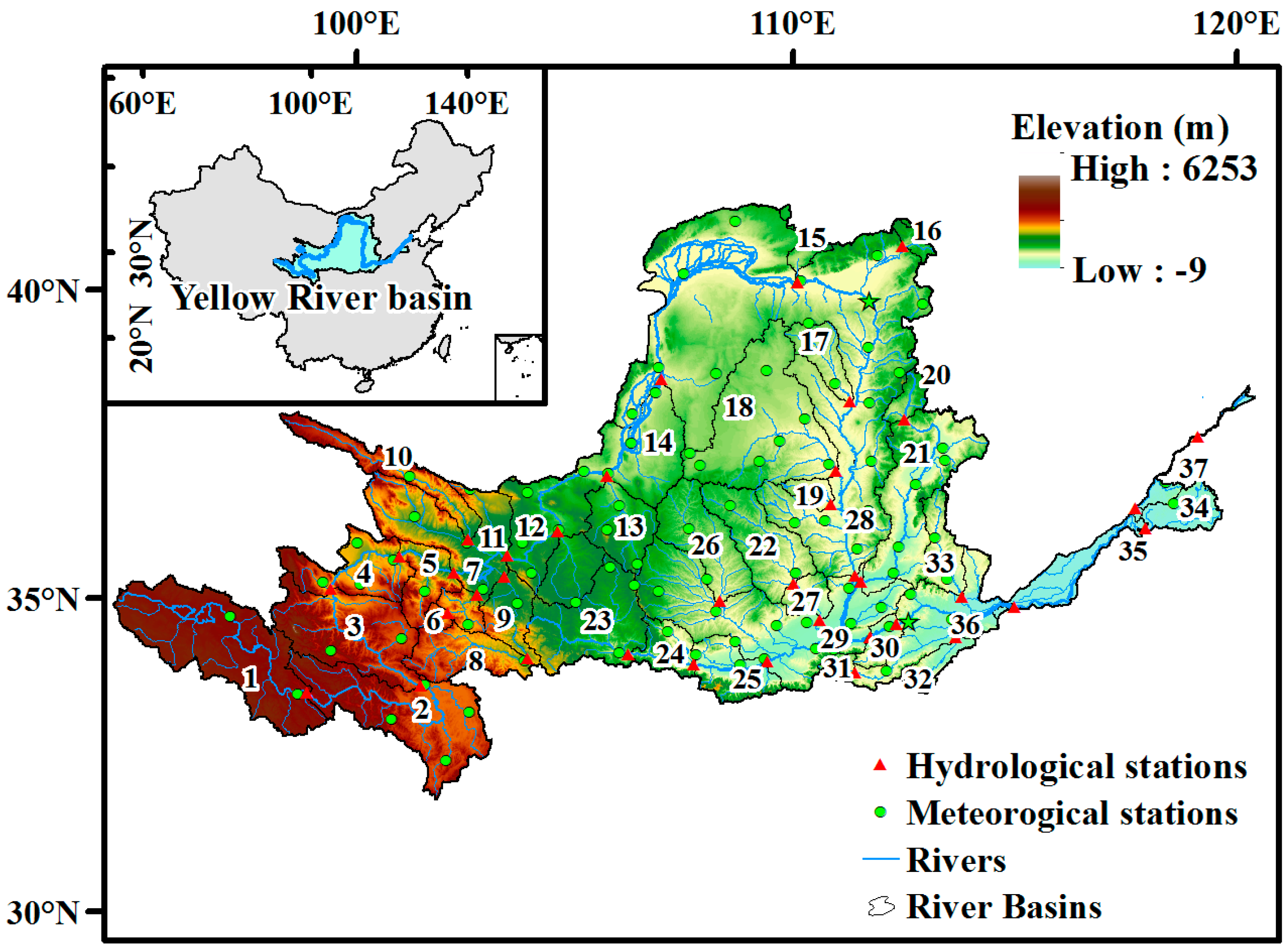

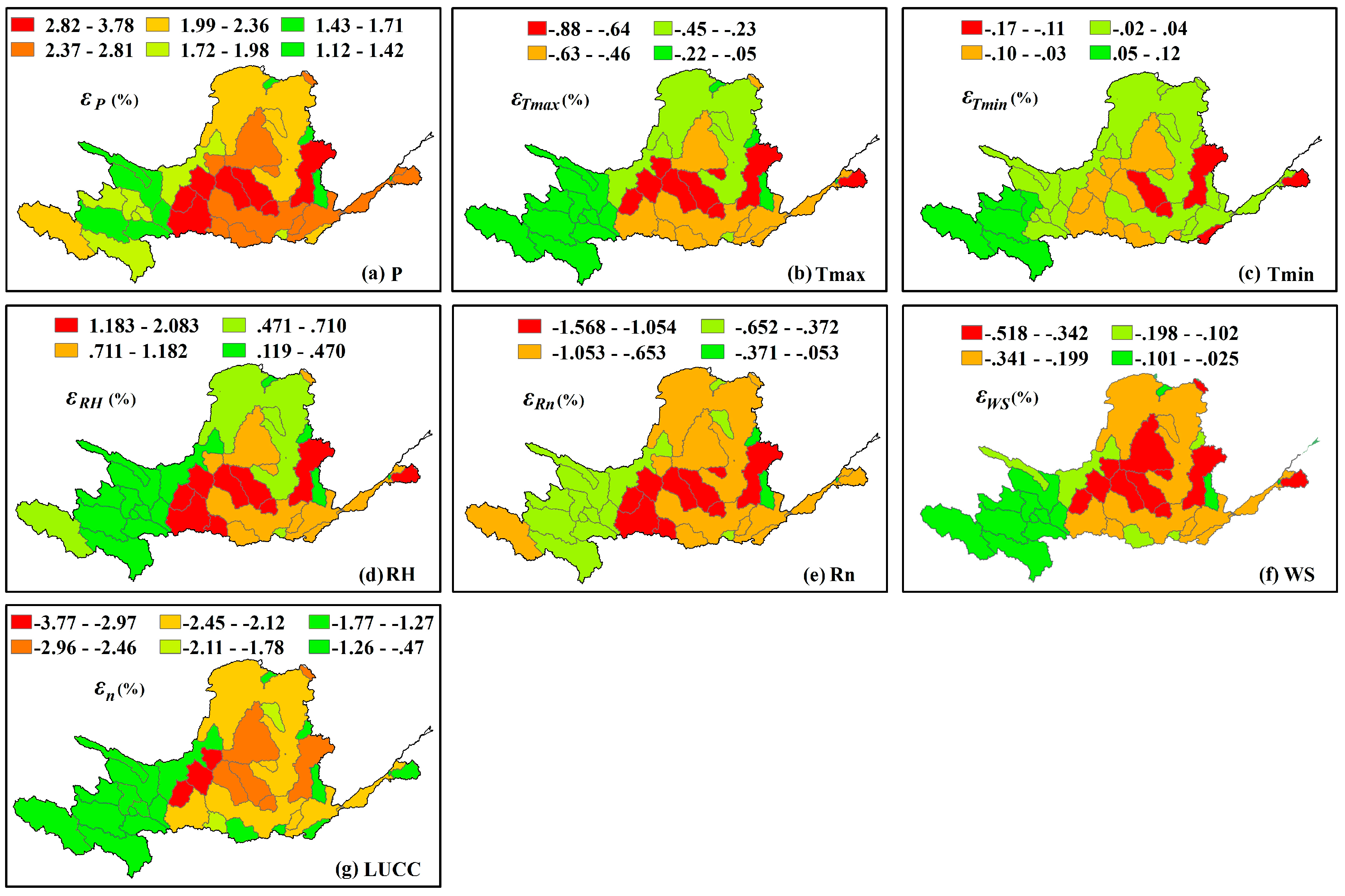
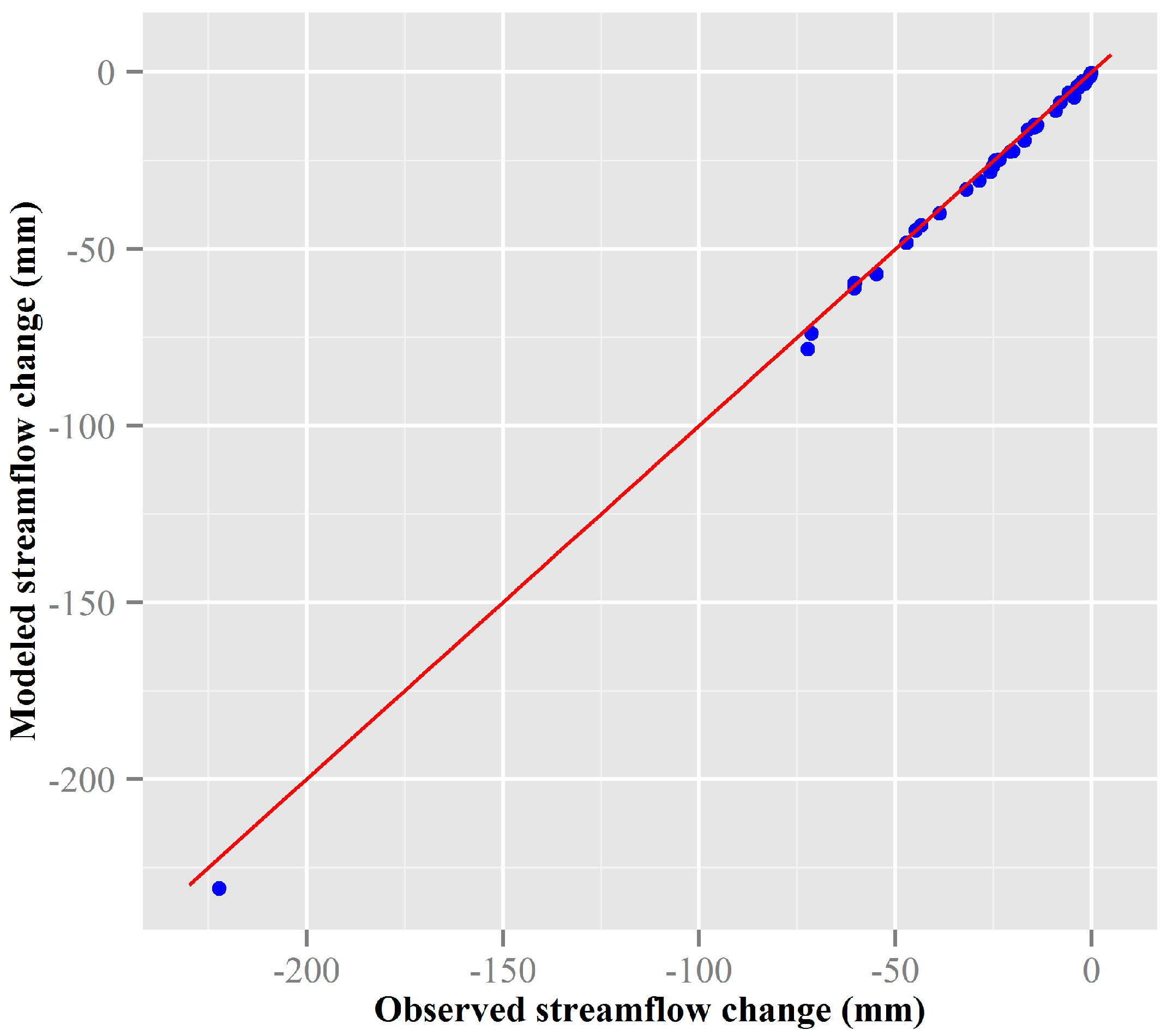
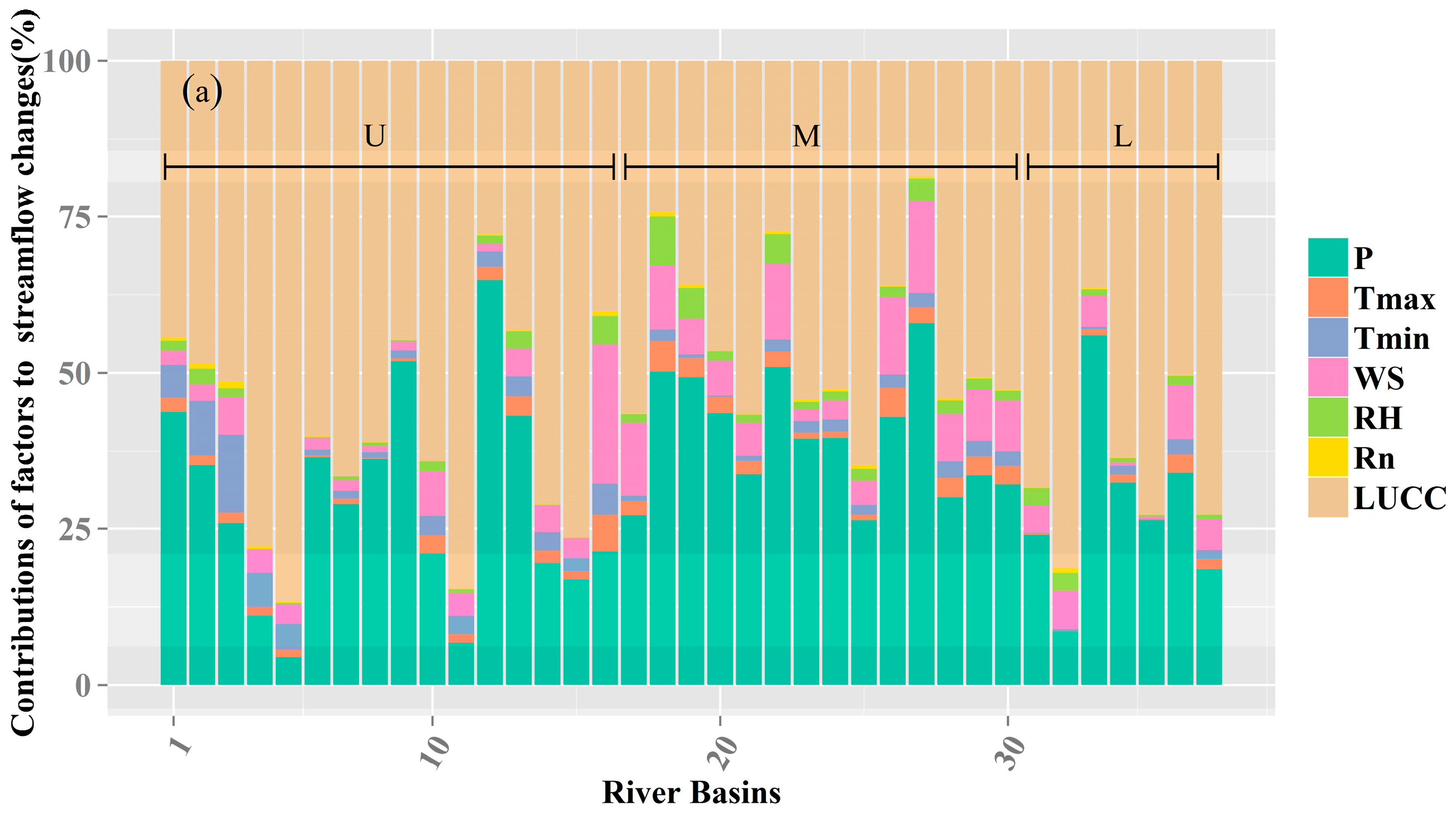



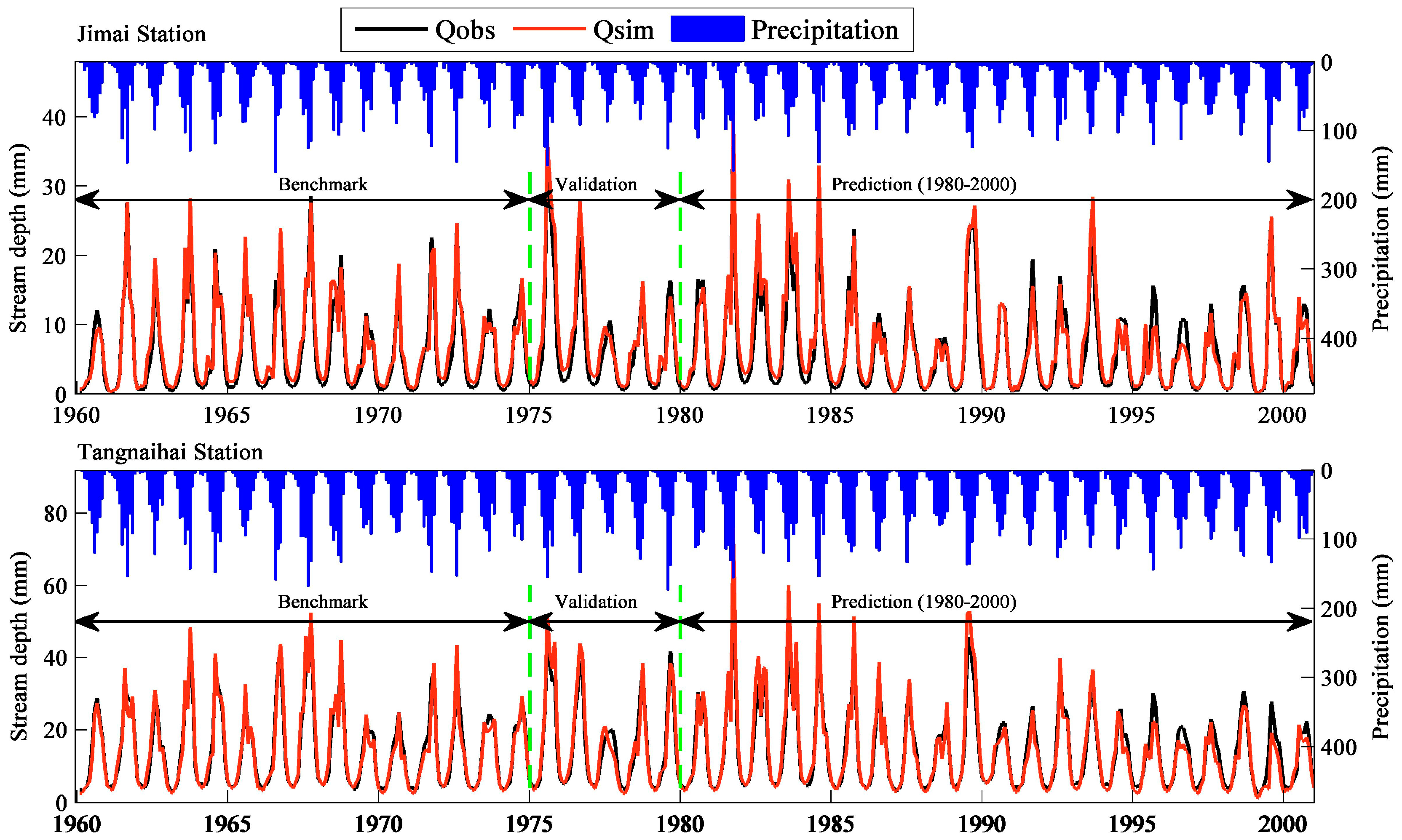
| Location | River | Hydrological Stations | No. | Drainage Area (104 km2) | Data Period | Annual P (mm) | Annual E0 (mm) |
|---|---|---|---|---|---|---|---|
| Upper basin | Main stream | Jimai | 1 | 4.86 | 1960–2000 | 434 | 849 |
| Maqu | 2 | 8.67 | 1960–2000 | 530 | 828 | ||
| Tangnaihai | 3 | 11.86 | 1960–2014 | 519 | 830 | ||
| Guide | 4 | 13.62 | 1960–2000 | 498 | 841 | ||
| Xunhua | 5 | 14.67 | 1960–2000 | 492 | 844 | ||
| Lanzhou | 6 | 20.65 | 1960–2014 | 468 | 854 | ||
| Shizuishan | 7 | 27.67 | 1960–2000 | 425 | 916 | ||
| Zuli River | Jinyuan | 8 | 1.07 | 1960–2000 | 397 | 921 | |
| Qinshui River | Quanyanshan | 9 | 1.43 | 1960–2000 | 358 | 1125 | |
| Kundulun River | Taerwan | 10 | 0.02 | 1960–2000 | 424 | 919 | |
| Zhao River | Minxian | 11 | 1.49 | 1960–2000 | 563 | 796 | |
| Hongqi | 12 | 2.49 | 1960–2014 | 539 | 804 | ||
| Daxia River | Shuangcheng | 13 | 0.40 | 1960–2000 | 489 | 831 | |
| Zheqiao | 14 | 0.62 | 1960–2000 | 501 | 809 | ||
| Datong River | Minhe | 15 | 1.51 | 1960–2000 | 374 | 896 | |
| Middle basin | Main stream | Longmen | 16 | 52.26 | 1960–2014 | 390 | 1031 |
| Sanmenxia | 17 | 65.12 | 1960–2000 | 428 | 1024 | ||
| Xiaolangdi | 18 | 66.22 | 1960–2000 | 429 | 1024 | ||
| Kuye River | Wenjiachuan | 19 | 0.86 | 1960–2014 | 402 | 1146 | |
| Fen River | Hekouzhen | 20 | 9.11 | 1960–2000 | 455 | 1057 | |
| Hejin | 30 | 3.94 | 1960–2000 | 487 | 1055 | ||
| Qingjian River | Yanchuan | 21 | 0.36 | 1960–2000 | 485 | 1059 | |
| Dahei River | Qixiaying | 22 | 0.27 | 1960–2000 | 359 | 1063 | |
| Wei River | Beidao | 23 | 2.75 | 1960–2000 | 506 | 863 | |
| Linjiacun | 24 | 3.54 | 1960–2000 | 530 | 868 | ||
| Xianyiang | 25 | 4.80 | 1960–2000 | 565 | 886 | ||
| Jin River | Yuluopin | 26 | 1.90 | 1960–2000 | 468 | 1032 | |
| Wuding River | Baijiachuan | 27 | 2.97 | 1960–2014 | 370 | 1187 | |
| Beiluo River | Jiaokouhe | 28 | 2.04 | 1960–2000 | 515 | 1022 | |
| Zhuangtou | 29 | 2.57 | 1960–2014 | 526 | 1043 | ||
| Lower basin | Main Steam | Huayuankou | 31 | 70.21 | 1960–2014 | 440 | 1027 |
| Lijin | 32 | 72.25 | 1960–2014 | 448 | 1029 | ||
| Yiluo River | Lingkou | 33 | 0.23 | 1960–2000 | 696 | 1021 | |
| Yi River | Longmenzhen | 34 | 0.53 | 1960–2000 | 752 | 1026 | |
| Qin River | Heishiguan | 35 | 0.93 | 1960–2000 | 564 | 1002 | |
| Dawen River | Laiwu | 36 | 0.03 | 1960–2000 | 700 | 1136 | |
| Daicunba | 37 | 0.84 | 1960–2000 | 813 | 1085 |
| Stations | SIMHDY-Based Results | Budyko-Based Results | ||||
|---|---|---|---|---|---|---|
| Streamflow (mm) | Calibration R2 | Validation R2 | Climate-Induced Contribution (%) | Climate-Induced Contribution (%) | Human-Induced Contribution (%) | |
| Jimai | −0.47 | 0.96 | 0.91 | 52.4 | 50.1 | 49.9 |
| Tangnaihai | −1.86 | 0.94 | 0.92 | 39.2 | 37.3 | 62.7 |
© 2017 by the authors. Licensee MDPI, Basel, Switzerland. This article is an open access article distributed under the terms and conditions of the Creative Commons Attribution (CC BY) license ( http://creativecommons.org/licenses/by/4.0/).
Share and Cite
Li, B.; Li, C.; Liu, J.; Zhang, Q.; Duan, L. Decreased Streamflow in the Yellow River Basin, China: Climate Change or Human‐Induced? Water 2017, 9, 116. https://doi.org/10.3390/w9020116
Li B, Li C, Liu J, Zhang Q, Duan L. Decreased Streamflow in the Yellow River Basin, China: Climate Change or Human‐Induced? Water. 2017; 9(2):116. https://doi.org/10.3390/w9020116
Chicago/Turabian StyleLi, Bin, Changyou Li, Jianyu Liu, Qiang Zhang, and Limin Duan. 2017. "Decreased Streamflow in the Yellow River Basin, China: Climate Change or Human‐Induced?" Water 9, no. 2: 116. https://doi.org/10.3390/w9020116





